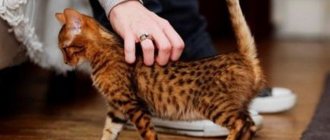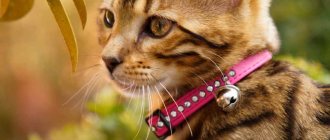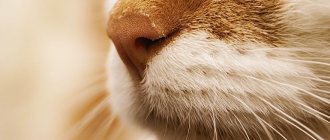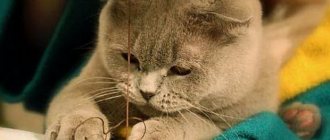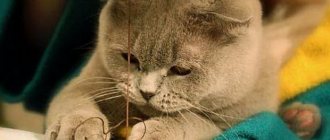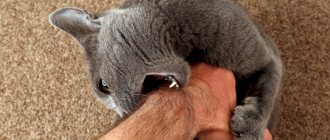Many mustachioed pets react positively to stroking, responding to affection with a loud purr and contented squinting. Soft fur and pleasant vibrations are the best anti-stress for a tired owner, but it is not always possible to relieve tension after work with their help. Even the most good-natured pets are sometimes not in the mood and greet their owner’s hand with a treacherous “bite.” Finding out the possible causes of dissatisfaction is quite simple if you know why cats love to be petted and which places on the body are best left untouched.
Why do cats like being stroked?
First of all, we note that cats have the most sensitive areas on their bodies. Vibrises are located there. These are hairs, similar in structure to whiskers, but smaller and thinner, they serve as the cat’s organs of touch. If you stroke your pet in the direction of the growth of the whiskers, she becomes very pleased, she is very pleased with such attention. But when you move your hand against the fur, the cat experiences discomfort. And if we are talking about representatives of short-haired breeds with coarse hair, then they even experience pain if stroked incorrectly. In this case, pets may simply stand up abruptly and run away, offended.
More sensual response
Although the prospect of a grooming request sounds like the strangest explanation, this explanation trumps all others. Many animal experts suggest that these tail tickles resemble mating with a male cat. The base of the tail has earned the reputation of the female cat's most sensitive erogenous zone.
When a male cat mounts a female in heat, the female raises her hind legs and the base of her tail is stimulated by dynamics. These seemingly harmless tail scratches can remind your cat of discomfort (and arousal) during mating, providing sensual or sexual stimulation. It might be best to stick to “safe zones” from now on.
Memories of childhood
A cat licks a kitten As cubs, all animals are in close contact with their parents, at least with their mother.
The mother not only feeds them, but also ensures cleanliness. Maintaining hygiene and even stimulating digestion in young mammals is achieved by licking. The mother carefully grooms the babies with her tongue and does this several times a day. The feeling of licking is remembered by the cubs for a long time, often for life . It is associated with the presence of the mother, and therefore with safety and satiety.
Read also: How to make a plate out of paper
Interesting fact : all babies can suffer from digestive problems, and the mother's tongue relieves abdominal pain. Therefore, licking is also associated with comfort and peace.
Touching a human hand and stroking it is so reminiscent of licking that it causes a rush of endorphins , which are called happiness hormones, in already matured animals. Even if the memory of the mother has long been erased, the release of hormones causes positivity - not to mention the fact that the stroking itself is also extremely pleasant. This is why cats and dogs love such touches so much, and often even ask for them.
Interesting: The largest animals - list, sizes, description, photos and videos
Do cats need hugs from their owners?
Contents hide
Do cats need hugs from their owners?
Some people, having barely read the title, will now mutter under their breath: “Needed - not needed... Why then did we get a cat in the first place? For comfort, warmth, tenderness and all sorts of hugs.” Everything is correct! Once upon a time, at the dawn of evolution, cats “domesticated” themselves. The benefit was mutual: for humans - food, shelter and protection, and for cats - the ruthless extermination of rodent pests. There is no doubt - cats are still successfully fighting the “gray scourge”. But over tens of thousands of years, city dwellers’ preferences have nevertheless changed: now cats are more guardians of the hearth, the personification of comfort and peace, than brave hunters. And how not to stroke and caress your pet! But let me ask a question: do cats really need our affection?
Are you already tense, dear cat lovers, and are you expecting loud revelations from the author? There will be no sensations: cats actually need our caresses and hugs. During joint games and petting, cats experience genuine pleasure, the so-called “happiness hormone” is released. It may be less than in the case of dogs, but it is really present!
So pet, scratch, cuddle your furry pets as much as you like. But don’t forget: cats are peculiar animals, don’t miss the cat’s warning signals when you should stop with “tenderness” and move on to other, more pressing matters.
American writer Meg Daley Olmert, a big cat lover, wrote a wonderful book called Made for Each Other: The Biology of the Human-Animal Bond. A common thread is the idea of how important the “happiness hormone” is for building “correct” relationships with pets. In other words, there is no need to be ashamed of your love, or tormented by the thought that animals “will not understand anything, because they are animals.” It is our little brothers who are instantly distinguished by sincere love, care and affection and always reciprocate.
Here are the results of a large-scale study conducted on this matter. Scientists worked with cats kept in 96 shelters in a variety of cities in the United States. You and I understand very well what a shelter is. The animals were divided into two groups. The cats from the first group were visited by the same person for ten days. He communicated with animals, stroked and caressed them. A “guest” also came to the cats from another group, but he averted his eyes and in every possible way avoided any bodily contact. The most ordinary setting for any shelter in the world! At the end of the experiment, the experimental purrs were examined by specialists. The cats with whom we interacted appeared outwardly healthy, active and cheerful. A completely different picture was observed in “ignored” cats: in addition to isolation, they even had respiratory disorders, as well as other diseases!
What conclusion can we draw? It is necessary (and simply necessary!) to communicate with cats. The bigger, the better. Research has shown a strong relationship between the emotional state of animals and their health. Happy, contented cats activate their so-called defense mechanisms more actively and produce antibodies that help resist infections. Let’s write it down like this: a beloved cat is a healthy cat!
Cats actually only seem so proud and independent. Life practice proves the opposite! The mustachios will take every opportunity to approach their owner, warm themselves, and feel his warmth. Of course: the owner is nearby - it’s always comfortable and safe, you can turn off the “alarm mode” and relax.
All cats are different, and you can find a “key” for each of them. These animals are observant by nature; they always look after their owners, even when they are sweetly dozing. And 24/7, please note. An observant cat will always accurately understand when to jump on your lap or rub sideways in order to count on reciprocity. This is especially noticeable when there are several cats in the house.
Some animals come to their owners’ beds for the night; for others, a couple of “duty” strokes are enough. But without the owner's love, cats cannot exist!
By the way, each cat has its own and unique “style”. Now we turn to experienced cat owners: remember, after all, each of your pets preferred something different! And now a piece of advice to everyone: please try to figure it out and understand which caresses bring the most pleasure to your pet! Don't be shy, be proactive and use trial and error. Don't be afraid of scratches - any communication is only beneficial.
We will continue the conversation in the next article, try not to miss it!
Photo: pixabay.com
Do cats like having their bellies scratched?
Has it ever happened to you that you start petting a cat, it falls to the floor and turns its belly towards you. You want to scratch it too, but in response the animal begins to bite and scratch. Why? What did you do wrong?
Of course, there are exceptions, but many veterinarians advise not to touch their belly. This makes sense when you consider how vulnerable this area is to injury. During a fight, a cat must protect its belly at all costs. So she can react sharply even to the owner’s touch.
Stroking technique
Experts who study animal behavior have repeatedly conducted experiments on how to pet a cat so that he likes it. As a result, we came to the conclusion that stroking should begin with an attempt to reach out and try to make several strokes on the head or torso. Based on the cat’s reaction, it will be noticeable whether the animal is currently predisposed to affection or not. If the cat moves away from your hand or tries to bite, then you should not anger him and stroke him against his will. If, on the contrary, the animal begins to rub against your hand, expose its head, back or stomach, then the cat is not against caresses.
About sensitive areas of the cat's body
An animal has many such areas:
- The area between the ear and eye. As a rule, it is not densely covered with hair in kittens and adults. Most of the scent glands are located there, precisely those with which the cat marks its territory.
- Middle of the forehead, area between the ears.
- The area of the muzzle between the nose and lips. These are the areas where the mustache grows. With such areas, cats and kittens always rub against the owner’s legs, marking him, as well as objects in the house, furniture.
- Lips, chin. When the owner gently scratches the lower part of the chin, the cat simply becomes touched and lifts his neck up, purring contentedly.
- The lower back is the base of the tail. It is difficult for a cat to scratch such a place on his own. He will be grateful to the owner for the massage.
- Stomach. Although animals do not have specific glands in this part of the body, the sensitivity of the zone is high. A cat can trust stroking its belly only to its closest person - its owner. A pregnant cat becomes calmer and more sensitive to touch. However, in recent weeks you should not stroke her belly - it is unpleasant for her.
Stomach
Another place that brings pleasure to cats is the stomach. You should only stroke his belly if the cat himself asks for it. Cats are animals that are very careful. Lying on their backs, they are very vulnerable, therefore, they do not always readily accept stroking in the abdominal area. Only when the cat feels that he is safe can he allow stroking in this place.
If you have noticed, dogs can often lie down in front of a person to have their belly rubbed, while cats, on the contrary, will never lie down on their backs in front of a stranger. Stroking the belly is a special privilege that is available only to those people whom the cat knows well and will completely trust. Such people usually include members of the family in which the cat lives.
© shutterstock
Why do cats love to be petted so much?
A love of stroking is characteristic of most mustachioed pets. There are three simple reasons for this.
Memory from childhood
For the first time after birth, only their mother takes care of the kittens. She feeds and licks them regularly, keeping their coats clean and stimulating digestion. Over time, the memory of the mother becomes clouded, but the pleasant feeling of comfort and security associated with touching the body remains.
Stroking a cat by a person is close in intensity to licking with the tongue. Due to the pleasant associations, it stimulates the production of endorphins, that is, joy hormones. With pleasure, the pet begins to purr and take a “milk step.”
Human touch is an expression of trust
Trust plays a big role in the formation of attachment. If a pet lives in comfortable conditions and is not subjected to physical punishment, then over time it begins to associate its owner with the image of its mother. A person's touch brings him pleasure and a sense of security.
Despite the importance of trust, some cats are very enthusiastic about cuddling up to people who are indifferent to them. Unlike avid cat lovers, such guests always behave quietly and reservedly, not trying to stroke or pick up the animal. Thanks to this, a person automatically falls into the category of objects with a minimum level of threat, which means that you can safely approach him for further acquaintance.
Physiological pleasure
Sensitive hairs called vibrissae are not only whiskers. They are located over the entire surface of the skin. When touched, the vibrissae send signals to the brain through neurons, causing very pleasant sensations throughout the body.
Physiological pleasure from petting increases during molting, but only if you run your hand in the direction of hair growth. If you stroke a cat against the grain, it will experience discomfort and even pain. This stroking lifts the guard hairs, irritating the nerve endings, and disrupts the adherence of the keratin scales, causing electrification.
Ears
A cat's ears have many nerve endings. Not surprising, since a cat has a hearing range from 3 to 45 thousand . Hz, while in humans it does not exceed 10 thousand Hz. Cats use their ears to guide them when choosing the direction of movement. In addition, this organ is very gentle and sensitive. Any touch to the ears causes discomfort in the cat.
© shutterstock
Exceptions
Even large animals, such as a horse or a cow, for example, love affection and stroking. A tender attitude towards them also forms a stable connection, and touches form devotion. But this aspect does not concern birds . Yes, many domestic parrots, for example, are calm about people’s touches and even enjoy them, but there is no association with the image of the mother.
Birds are an exception
It's simple: birds do not lick their chicks, they clean the young with their beaks . And their memory is weaker, which excludes the formation of associations with periods of life that are already in the past.
Interesting: Why is Christmas on January 7th? Reasons, photos and videos
Only mammals can truly enjoy human touch , and those of them that were either born domesticated and had contact with humans since childhood, or were timely and competently tamed with the formation of complete trust in humans.
Thus, pets love to be petted as they associate it with their mother's touch. Cats, dogs and other animals lick their young to maintain cleanliness, and human stroking most closely resembles the touch of a mother's tongue. If you pet your cat or dog, it knows that you love and care for it, this gesture is understandable to animals without any translation.
What makes this reaction "weird"?
No matter how finicky and introverted they may be, cats crave physical affection. Gentle scratching behind the ears and chin (“safe zones”) can develop into purring and overwhelming drowsiness. However, once the base of the tail becomes your main target, this calming response suddenly ends.
This "strange" reaction can range from mild to attention-grabbing, including:
- Long, drawn out, high frequency vocalizations
- Lifting your butt up (also known as "lifting your butt")
- Turning back to bite or bite your hand
- Impulsive air licking or side scratching
- tipping to the floor
- Similar to marching or pacing in place
- The appearance of ripples under the skin of the back
Even those who are good at translating cat language will have difficulty understanding this unintelligible code. Is a raised butt a good sign? Should you scratch more or stop altogether? Are you crossing the line between friendliness and aggression?
These are all valid questions. The correct answer depends on your cat's personality, nervous sensitivity, and territorial instincts.
The domestic cat's butt-scratch reflex may seem absurd at first glance, but is this reaction natural throughout the cat kingdom? The amazing answer is in this video:
Even the most bizarre cat habits have a reasonable explanation. For example, cats knock objects off tabletops to imitate "hunting" and cover empty food bowls to ward off scavengers. The exaggerated, full body curves produced by scratching the base of the tail are no different from this. Let's look at why these innocent caresses make your cat so angry, excited, and responsive.
Where can I iron
Often cats themselves hand over those parts of the body that need scratching or ironing. But if you want to pet an unfamiliar cat and don’t know its preferences, in order to avoid conflict situations, it is better to adhere to the following scheme and recommendation:
- Head and muzzle . Cats simply love to have their cheeks, chin and, of course, scratched behind their ears. They also don't mind being petted on the head.
- Many cats love to have their chest and neck .
- When stroking the back, the movements should be soft and smooth, from head to tail.
- scratching their lower back , but it is better not to touch their tail.
Each pet has its own character, so everyone has their favorite and forbidden places. If your cat doesn’t like having her lower back scratched, for example, you shouldn’t do it.
Head
Almost all cats don't mind having their heads stroked. But, try not to touch their ears with your hand. This is a special and very sensitive organ, the touch of which is not very pleasant for the cat. One of the places that brings the most pleasure for almost all cats is the upper part of the bridge of the nose and forehead. Gently stroking your fingers in this place has a very beneficial effect on the cat. The thing is that this is the point at which in childhood, each kitten is licked by the mother, washing them. Apparently, these pleasant memories are embedded in every kitten on a subconscious level, therefore, when stroked in this place, they experience very pleasant feelings.
© shutterstock
What if my cat doesn't like being petted?
Let's remember the survey results. There are few such cats, but they still exist. And these are not necessarily street cats. Some indoor cats that were born and raised indoors may not like being stroked. These are usually shy animals that still prefer to keep their distance.
And this does not mean that the cat does not love you. Just let her determine the type of interaction that is convenient for her.
Respect your cat's personal boundaries, and perhaps over time she will begin to allow you more.
Which cats are the most affectionate and calm?
In order to understand which cat breed is the most affectionate and tame, you need to pay attention to the pet’s attitude towards those around him. It is the ability to behave in society that can show how much an animal trusts a person.
The criteria for determining whether pets are friendly and ready to show their feelings are:
- attitude towards the owner and other household members;
- interaction with other animals;
- behavior in stressful situations or unfamiliar surroundings;
- temperament.
Exchange of smells
Why does a cat, when it meets its owner, rub its muzzle against his clothes? Some believe that she is being caressed in this way. However, this is not quite true. Cats have glands on their faces that secrete a special substance. When a pet rubs against its owner, it leaves its scent on the clothes - it marks it. You may not be able to detect the scent, but other animals can distinguish it very clearly.
The most acceptable way to exchange scent is through stroking. After all, the glands are located not only on the muzzle, but also in the area of the ears, on the pads of the paws and lower jaw. If the cat begins to move its paws, it stimulates the secretion of secretions from the glands.
Possible medical explanations
A cat with a healthy nervous system may feel a slight tickling sensation when scratched above the tail. However, in cats with feline hyperesthesia syndrome (FHS), even lightly stroking the area can mimic a painful electric shock. 40 years after the discovery of this disease, veterinarians still do not understand the mechanisms underlying this debilitating neurological disorder.
Cats with FHS—aptly nicknamed “rolling skin syndrome”—may experience abnormally sensitive skin and other symptoms that include:
- Bizarre growls or vocalizations
- Unexplained dilated pupils
- Urinating outside the toilet
- Twitching or rolling sensation in the back
- Sudden bouts of running around the house
- Staring into space (looking at something that is not there)
- Tail tucked due to pulsating or crawling sensations.
A cat with feline hyperesthesia syndrome may hiss, growl, or attack its tail to the point of damage—with or without previous tickling over the tail. If you suspect your cat's strange reaction is outside of the "typical" range, visit your veterinarian to rule out more sinister explanations.
The most sensitive areas of cats
The favorite places for stroking are those areas of the cat's body where the aforementioned “odorous” glands are located, or rather those where there are the largest number of them. For this reason, the most “pleasant” places are:
- The middle of the forehead located between the ears.
- The area located between the ear and eye. This area in cats is somewhat “bald” due to the sparser fur than on the rest of the body. Moreover, it is rarer not only in adults, but also in small kittens. It is assumed that this is where the maximum number of “scent” glands are located, with which the cat marks its property.
- Angle between nose and lips. These are the very places where cat whiskers grow. This is the area where a cat most often rubs against household furniture and its owner’s legs.
- Lips and chin: scratching these places gives cats the most pleasure.
- The lower part of the back located at the base of the tail.
There are no scent glands on the abdomen, but this area is very sensitive to touch. And only if the pet has maximum trust in its owner will it lie on its back and allow it to stroke its belly.
What about scratching?
Scratching involves a more intense impact, but cats also like it and resemble a massage. The greatest pleasure comes from touching the areas with odorous glands:
- chin;
- cheeks;
- between the ears;
- bald area between the eye and ear;
- base of the tail.
Animals use the pheromones they contain to mark their territory and owners. Voluntary “smearing” a person into a secret is a kind of declaration of love and an expression of respect for one’s mustachioed pets.
Maine Coon
Who would have thought that behind a formidable big cat could be hidden an affectionate companion and a loyal friend? Maine Coons amazingly combine stateliness with affection and caring.
Fluffy, robust creatures are indescribably delighted when they have the opportunity to play. The solid weight and size add a fun touch to the whole fun process.
Important! The Maine Coon, contrary to all rumors, will never attack. These animals are very friendly, so they will only put out their claws as a last resort.
Maine Coons are not only very affectionate pets, but also very caring. Whenever necessary, this furry knight will rush to the rescue. They can calm a person down with their loud melodic purring and will try to participate in all household chores.

